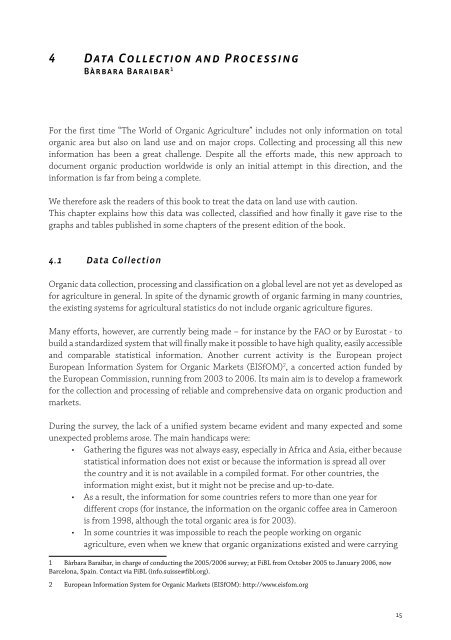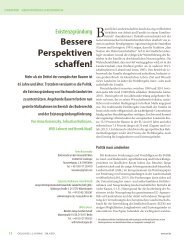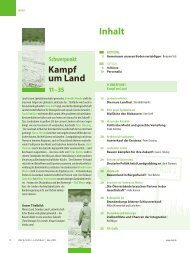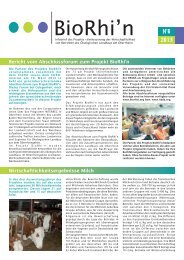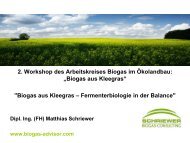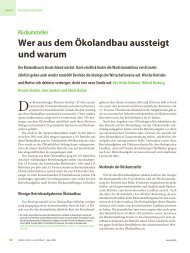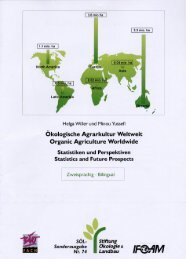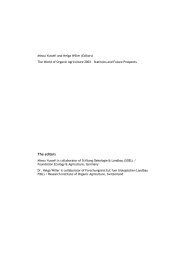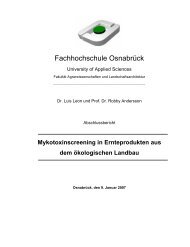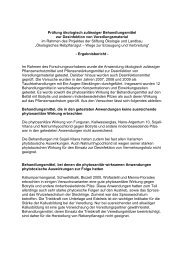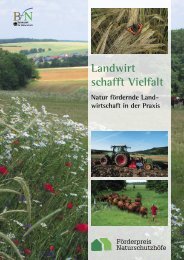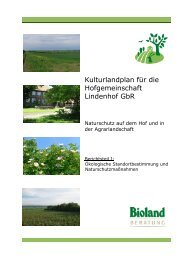the world of organic agriculture - Organic Eprints
the world of organic agriculture - Organic Eprints
the world of organic agriculture - Organic Eprints
Create successful ePaper yourself
Turn your PDF publications into a flip-book with our unique Google optimized e-Paper software.
4 Data Collection and Processing<br />
Bàrbara Baraibar 1<br />
For <strong>the</strong> first time “The World <strong>of</strong> <strong>Organic</strong> Agriculture” includes not only information on total<br />
<strong>organic</strong> area but also on land use and on major crops. Collecting and processing all this new<br />
information has been a great challenge. Despite all <strong>the</strong> efforts made, this new approach to<br />
document <strong>organic</strong> production <strong>world</strong>wide is only an initial attempt in this direction, and <strong>the</strong><br />
information is far from being a complete.<br />
We <strong>the</strong>refore ask <strong>the</strong> readers <strong>of</strong> this book to treat <strong>the</strong> data on land use with caution.<br />
This chapter explains how this data was collected, classified and how finally it gave rise to <strong>the</strong><br />
graphs and tables published in some chapters <strong>of</strong> <strong>the</strong> present edition <strong>of</strong> <strong>the</strong> book.<br />
4.1 Data Collection<br />
<strong>Organic</strong> data collection, processing and classification on a global level are not yet as developed as<br />
for <strong>agriculture</strong> in general. In spite <strong>of</strong> <strong>the</strong> dynamic growth <strong>of</strong> <strong>organic</strong> farming in many countries,<br />
<strong>the</strong> existing systems for agricultural statistics do not include <strong>organic</strong> <strong>agriculture</strong> figures.<br />
Many efforts, however, are currently being made – for instance by <strong>the</strong> FAO or by Eurostat - to<br />
build a standardized system that will finally make it possible to have high quality, easily accessible<br />
and comparable statistical information. Ano<strong>the</strong>r current activity is <strong>the</strong> European project<br />
European Information System for <strong>Organic</strong> Markets (EISfOM) 2 , a concerted action funded by<br />
<strong>the</strong> European Commission, running from 2003 to 2006. Its main aim is to develop a framework<br />
for <strong>the</strong> collection and processing <strong>of</strong> reliable and comprehensive data on <strong>organic</strong> production and<br />
markets.<br />
During <strong>the</strong> survey, <strong>the</strong> lack <strong>of</strong> a unified system became evident and many expected and some<br />
unexpected problems arose. The main handicaps were:<br />
• Ga<strong>the</strong>ring <strong>the</strong> figures was not always easy, especially in Africa and Asia, ei<strong>the</strong>r because<br />
statistical information does not exist or because <strong>the</strong> information is spread all over<br />
<strong>the</strong> country and it is not available in a compiled format. For o<strong>the</strong>r countries, <strong>the</strong><br />
information might exist, but it might not be precise and up-to-date.<br />
• As a result, <strong>the</strong> information for some countries refers to more than one year for<br />
different crops (for instance, <strong>the</strong> information on <strong>the</strong> <strong>organic</strong> c<strong>of</strong>fee area in Cameroon<br />
is from 1998, although <strong>the</strong> total <strong>organic</strong> area is for 2003).<br />
• In some countries it was impossible to reach <strong>the</strong> people working on <strong>organic</strong><br />
<strong>agriculture</strong>, even when we knew that <strong>organic</strong> organizations existed and were carrying<br />
1 Bàrbara Baraibar, in charge <strong>of</strong> conducting <strong>the</strong> 2005/2006 survey; at FiBL from October 2005 to January 2006, now<br />
Barcelona, Spain. Contact via FiBL (info.suisse@fibl.org).<br />
2 European Information System for <strong>Organic</strong> Markets (EISfOM): http://www.eisfom.org<br />
15


